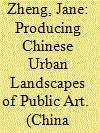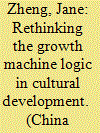| Srl | Item |
| 1 |
ID:
168178


|
|
|
|
|
| Summary/Abstract |
This article uses an “urban landscapes” perspective to examine the urban sculpture scene and its production system in Shanghai. It reviews both the national urban sculpture discourse and urban sculpture planning practices since 1949, and then focuses on Shanghai specifically. It examines three major stakeholders in urban sculpture development and their interactions. The main argument is that Shanghai's urban sculpture scene has evolved due to the proliferation of aesthetic and symbolic sculptures as opposed to traditional monuments; however, urban entrepreneurialism and globalization have been shaped by the continuity of the Chinese ideological framework, which has transformed urban sculptures from explicit into veiled political didacticism under the guise of caring for the people.
|
|
|
|
|
|
|
|
|
|
|
|
|
|
|
|
| 2 |
ID:
189972


|
|
|
|
|
| Summary/Abstract |
Using urban sculpture planning in Shanghai as a case study, this article aims to understand the process of planning cultural projects in China and to evaluate the applicability of the growth machine model to the social dynamics underlying cultural development in Chinese cities. Based on interviews with sculpture planning officers in 10 districts and the municipality, as well as 56 companies that have been involved in sculpture projects in Shanghai, this article argues that the growth machine model is of limited applicability to urban sculpture planning in Shanghai. Instead, a public-sector-centred tripartite model is more applicable for the following reasons. First, most cooperative relationships in key cultural development projects engage state-patronized public corporations instead of the private sector. Here the government plays a dominant role. Second, public–private partnership is rare and loosely formed. The broadly defined concept of shared cultural capital that includes personal artistic tastes, altruistic motivations, and brand building concerns engenders public–private cooperation. Third, the local state adopts a laissez-faire approach to most of the private-sector-invested cultural projects that the government considers to be less crucial to its vision for Shanghai’s art landscape.
|
|
|
|
|
|
|
|
|
|
|
|
|
|
|
|